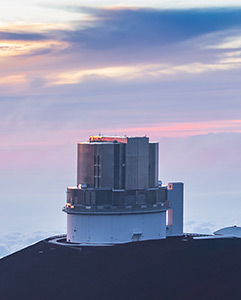Japan’s Subaru telescope, located atop Hawaii’s 14,000-ft. Mauna Kea, presented many complex engineering design concerns, including fabricating the enormous glass blank that serves as the primary mirror, and maintaining its accurate shape during observation. The single primary mirror structure:

- Weighs 33 tons
- Measures 8.31 meters (27.24 ft.) in diameter
- Is only 20 cm (8 inches) thick
- Has a 40.1 ratio of diameter to thickness
- Requires a highly precise shape
- Possess the smallest possible coefficient of thermal expansion (CTE)
To meet the primary mirror requirement, a giant disk was fabricated out of an ultra-low-expansion (ULE) glass. To support this primary mirror and maintain an accurate shape during observation, the Subaru telescope has an active mirror support system that employs 261 actuators and high-precision load sensors. At the top of each actuator in the mirror support system, embedded in the glass disk, are 261 specially designed sleeves made of Super Invar 32-5 Alloy*, a specialty alloy that provides minimum thermal expansion at ambient temperatures and minimizes the difference between the CTEs of the glass and the alloy.
The load sensors monitor any deformation of the mirror due to gravity when the telescope tilts. A control computer analyzes that information, then drives the actuators every tenth of a second to compensate for any distortion of the mirror. The sleeves rest on tapered balls made of chrome-nickel-moly steel with galvanized surfaces to protect the sleeves’ thin nickel coating.
Super Invar 32-5
Super Invar 32-5 is a low expansion alloy consisting of 32% Nickel, 5% Cobalt, and balance Iron. Super Invar Alloy exhibits minimum thermal expansion at room temperatures (one half of Invar Alloy), as well as thermal expansion properties less than that of Invar Alloy in the 67/203°F (-55/95°C) temperature range. The minimal expansion of Super Invar over this range of temperatures makes this alloy useful in many applications including structural components and substrates in instrument systems requiring precision measurements including optical instruments, telescopes, laser instruments and equipment, ring laser gyroscopes, laser benches, positioning devices, metrology devices, substrates in instrument systems requiring precision measurements, and other applications that require lower expansivity than Invar Alloy provides.
